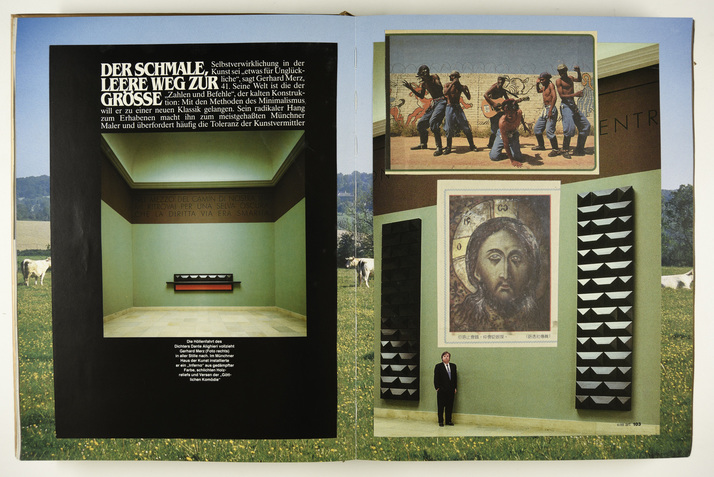-
From Current Issue
-
- Editor’s Letter Fire in the Heart
- Reviews I Gusti Ayu Kadek Murniasih
- Reviews 11th Seoul Mediacity Biennale: “One Escape at a Time”
- Dispatch Networked China
- One on One Monira Al Qadiri on Yukio Mishima
- Essays The rise of independent art spaces in pandemic-era Shanghai
- Features Tuan Andrew Nguyen
- Table of Contents
- Web Exclusives
- Archive
- Subscribe

R
E
V N
E
X
T
Installation view of RAQS MEDIA COLLECTIVE’s Unledgered, 2020, mixed media, video installation in loop: 1 min 30 sec, at “Portals, Stories, and Other Journeys,” Tai Kwun Contemporary, Hong Kong, 2021. Courtesy Tai Kwun Contemporary and Asia Art Archive (AAA), Hong Kong.
The Eclectic Possibilities of “Portals, Stories, and Other Journeys”
Although Ha Bik Chuen (1925–2009) was primarily known as a sculptor and printmaker, his archival practice was just as vital to his artistic life. For three decades, Ha documented more than 2,500 exhibitions by scrupulously collecting photos, contact sheets, printed matter, and other ephemera, often reworking these documents into collages. An earnest autodidact, Ha also amassed a library of books on art and visual culture. In 2013, after the artist’s passing, his family entrusted the archive to AAA. “Portals, Stories, and Other Journeys” at Tai Kwun was born out of the nonprofit’s ongoing exploration of Ha’s prolific archive, and features nine “sets” in which AAA and a group of international artists respond to Ha’s practice in diverse and unexpected ways.
Glowing screens, projections, and monitors illuminated the dim exhibition space, evoking flickering portals that lured visitors closer to their thresholds. Throughout the exhibition, archives are alluded to as entryways into realms of knowledge. Projected onto two adjacent walls near the entrance was A Giant Flipbook (2021), a two-channel video in which disembodied hands leaf through Ha’s bound collages, revealing snippets from interior design books, local newspapers, and art magazines in a playful juxtaposition of canonical art with pop culture. Colorfully mismatched audience chairs resonated with the photo fragments onscreen, which exude a blithe irreverence, as seen in one composition featuring a magazine cut-out of a woman’s torso—clothed only in animal-print underwear—plastered next to a picture of a half-masked man. The floating hands flip through Ha’s pages carefully, pausing every so often as if to mark the unseen viewer’s quiet contemplation. The video’s audience is thus faced with a palimpsestic layering of portals: the screen lends way to the collage, which opens to reveal photographs, which are, in turn, records of pre-existing objects. These portals allow viewers to access certain realities, yet the process is mediated by translations, distortions, and reimaginings that generate new meaning, an incessant and subjective creative process hinted at by the constant labor of the video’s hands.
The unstable relationship between archives and meaning is further explored in A Shadow Play (2021), which involves a sculpture of Lo Ting, a half-fish, half-human creature originally dreamt up by Hong Kong artist Oscar Ho. On the verge of the Handover, Ho mounted an eccentric exhibition presenting the parafictional fish-man as an archaeological discovery. (Ha’s photos of this exhibition appeared in a vitrine for another set.) To grant Lo Ting credibility, Ho’s project cheekily addressed participating artists as excavators and claimed links to made-up research groups with official-sounding names. Ho’s narrative framed Lo Ting as a folkloric forefather of Hong Kong people, alluding to local anxieties toward identity and transition at a historical moment when Hong Kong was shifting from colonial to post-colonial rule. In A Shadow Play, a reproduction of the glum, blank-eyed creature appears arrested mid-pace, resembling depictions of proto-humans on an evolution diagram. Because Lo Ting is obscured behind a projector screen depicting ochre-tinged snapshots of Hong Kong’s mountains, only the creature’s lumpy, somewhat pitiful shadow first enters one’s view, prompting visitors to enact their own kind of excavation—stepping behind the occluding surface—in order to see Lo Ting clearly. Both obscuring and emphasizing the creature’s ambiguous form, A Shadow Play alludes to the way that archives can perpetuate apocrypha, obfuscating truth and fiction. Even the most legitimate-seeming portals, Ho points out, may take us to false realities.
Curator Michelle Wong mentioned that the sets were intentionally left unnumbered at the venue so that visitors could find different resonances in their own walkthroughs (although they were numbered in the guidebook’s map). Indeed, “Portals, Stories, and Other Journeys” did not try to assert any single narrative of Hong Kong’s art history or of Ha’s personal practice. “I find it most invigorating when an archive—instead of foreclosing stories—leads us to question and contend dominant narratives,” Wong explained. Both makers and fakers of meaning, the portals of this show enthralled viewers with their eclectic possibilities.
Gabrielle Tse is an editorial intern at ArtAsiaPacific.
“Portals, Stories, and Other Journeys” is on view at Tai Kwun Contemporary, Hong Kong, until August 1, 2021.
To read more of ArtAsiaPacific’s articles, visit our Digital Library.













